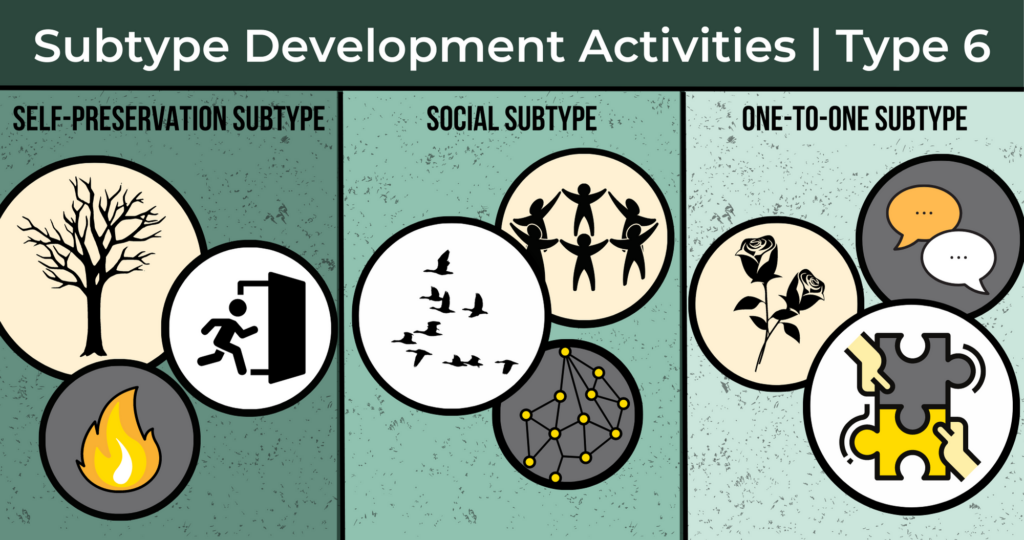There are three versions of each Enneagram type called subtypes: self-preserving subtype, social subtype and one-to-one subtype. Subtypes are formed when the emotional patterns or habits of our type, also called the type’s passion or vice, intersect and combine with one of the three basic human instincts, the instinct that is most activated within us: self-preservation instinct, social instinct or one-to-one instinct. We may have more than one activated instinct, so we could relate to two or even all three subtypes for our type.
Each instinct has specific focal areas. Individuals with that activated instinct, once it combines with the emotional pattern of our type, may move toward that instinctual area, away from that arena, or have ambivalence about that area. A way of understanding this is that the instincts by themselves are simply human and natural. However, when the activated instinct(s) combines with our type-based emotional pattern, the instinct then becomes distorted and, thus, less able to satisfy our natural needs in that instinctual area.
Here you can read about the passion or emotional habit of the type, a name for and a description of that subtype as it combines the emotional habit with that instinct, followed by one specific development idea that is particularly useful to people of that subtype. Please remember that we may have more than one active subtype, so the development activities for the additional subtype are also good for your development.
SIXES
Emotional pattern of FEAR
Fearing that something bad or negative will happen and doubting that others are trustworthy or that they and you are capable of meeting the challenges that arise
Self-preservation Six subtypes
Self-Preservation Six subtypes (“fear”) have an intense need to feel protected from danger, often utilizing the family, a surrogate family or support groups to provide this, and they use their friendliness thinking no harm will come to them if they a warm toward others and also believe there is safety by being friendly to others and part of a group.
Self-preservation Six subtype development
Notice how often you question everything and act overly warm toward others as a way to feel safe; learn to relax your self-doubt and the need to ingratiate yourself.
One way to relax your self-doubt and the need to ingratiate yourself:
Consider this idea: You use your self-doubt to feel safe, making sure you have considered multiple pathways so you choose the route with the least probable negative outcomes. However, your continuous doubt actually makes you feel less certain and safe. It’s paradoxical.
Social Six subtypes
Social Six subtypes (“duty” ) focus on rules, regulations, and prescribed ways of behaving within their social environment in order to keep their behavior acceptable and to not get chastised or punished by authority figures.
Social Six subtype development
Notice how you rely on rules and compliant relationships with authorities in order to feel safe; learn to relax your reliance on rules, your compliant relationships with authority figures, and your overly strong sense of duty to groups to which you belong.
One way to relax your reliance on rules, your compliant relationships with authority figures, and your overly strong sense of duty to groups to which you belong:
Think about all the authority figures you’ve had in your life and how you related to them. Often you’ll discover that you have been extremely compliant in these relationships to deal with your fears and potentially secure your safety. Has this worked for you in the past? Explore your fears and what you may be giving up as a result of your compliance.
One-to-One Six subtypes
One-to-One Six subtypes (“strength/beauty”) deny their own anxieties by pushing against their fear, appearing bold, confident, charismatic, and sometimes fierce or fearless. This subtype of Six is often referred to as a counter-fear or counter-phobic Six because they try to prove, often unconsciously, that they have no fear.
One-to-One Six subtype development
Notice how you rely on “shows of strength” and being compelling and charismatic as a way for you to feel safe; learn to let go of your armor in whatever form it appears.
One way to let go of your armor in whatever form it appears:
The most important thing you can do is to slow down your response when you move so quickly to action. With little if no pause between the stimulus and your response, you are likely unaware that fear is driving you. So slow down, push pause and explore how you are feeling and what is occurring within you. The pause button is a great ally in your development.
These activities are excerpts from the new additions to the soon-available 3rd edition of The Enneagram Development Guide, with over 60 development activities for each Enneagram type.
Ginger Lapid-Bogda PhD, author of nine Enneagram books, is a speaker, consultant, trainer, and coach. She provides certification programs and training tools for business professionals around the world who want to bring the Enneagram into organizations with high-impact business applications. TheEnneagramInBusiness.com | ginger@theenneagraminbusiness.com


Comments are closed.